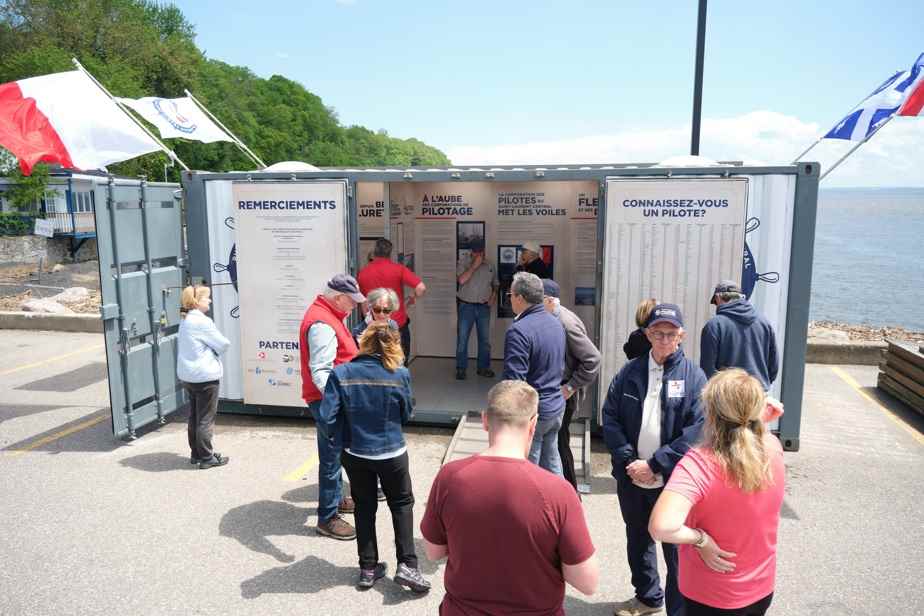Posted at 11:30 a.m.
The Corporation of Central St. Lawrence Pilots is organizing a traveling exhibition this summer, a sort of museum in a container, to mark its 150e anniversary.
“It’s a great excuse to meet the neighboring communities and to publicize our work, which is little known,” says Pascal Desrochers, president of the Corporation and himself a pilot.

PHOTO PROVIDED BY THE CENTRAL ST. LAWRENCE PILOTS CORPORATION
This container contains a lot of information on piloting on the St. Lawrence.
A pilot is a specialist who takes the helm of a ship when it enters a complex navigable sector, such as the St. Lawrence. In fact, navigation on the river is so delicate that it takes three different pilots between Les Escoumins and Montreal.
“Between Les Escoumins and Quebec, we work a lot with the tides and microclimates,” says Mr. Desrochers. Upstream from Quebec, the river narrows a lot, there is always the effect of the tide which is very important. Upstream from Trois-Rivières, there is no more tide, but we face a narrower, more winding channel, much less hollow. It is the very nature of our work to know a particular section. »

PHOTO DAVID BOILY, LA PRESSE ARCHIVES
Navigating the St. Lawrence is not easy: each section has its own requirements and, therefore, its assigned pilots.
This is how Mr. Desrochers is pilot for the section between Trois-Rivières and Montreal. In this sector, the dredged channel is particularly narrow, at 245 m. Once engaged, large ships 300m long cannot turn back.
Winter navigation is also problematic. The presence of ice makes positioning systems less accurate and radars less effective. In addition, buoys are removed in winter. “My pilot’s license does not allow me to be a pilot in another sector: I would be completely useless and incompetent there”, specifies Mr. Desrochers. To pilot elsewhere, he would have to resume a good part of his apprenticeship.
A family matter
The training of a pilot can take about fifteen years. You must first study navigation for four years in a specialized school, such as the Institut maritime du Québec in Rimouski, then sail for five years to obtain a captain’s certificate, follow a two-year apprentice pilot course and finally perform 300 missions with a licensed pilot.
For many pilots, it’s a family affair.
As it is an unknown profession, it is difficult to attract people who have no knowledge in this profession. I come from a family of sailors: my father was a pilot, he had been initiated by his uncles.
Pascal Desrochers, pilot and president of the Corporation of St. Lawrence Pilots
His father was a native of Lotbinière, which is precisely one of the cradles of piloting in Quebec. “If we go back to the 1800s and the early 1900s, there were two pools of pilots: one in Deschambault, on the north shore, and the other opposite, in Lotbinière. »
Of course, technologies have changed over time, electronic tools have come to support visual methods of navigation. However, these remain fundamental.
“Basically, our work is with the eyes. One can situate oneself with a line of visual positioning. If I line up a church steeple with a grower silo, it gives me a line of positioning, I know where I stand, there can be no mistake. With GPS, there are days when the signal is less good. With radar, there are errors that are included, you have to interpret the data. »

PHOTO DAVID BOILY, LA PRESSE ARCHIVES
The mode of transhipment has not changed over the years: pilots must climb or descend a rope ladder, as here off Les Escoumins in 2019.
Nor has the mode of pilot transshipment changed over the years. “We will present ourselves at the side of the ship [à bord d’un bateau pilote], we climb a rope ladder and come on board. For us, this is the most intense, the most dangerous moment. »
And not just a little: worldwide, two to three pilots lose their lives each year during these manoeuvres. “On our section, we are lucky, we are in more sheltered waters, the risks are low. But they are present. »

PHOTO PROVIDED BY THE CENTRAL ST. LAWRENCE PILOTS CORPORATION
In this box, a museum exhibition
It is this information, and more, that can be found in the museum container. The exhibit is free and self-guided, but on weekends active and retired pilots are on hand to answer questions.
The 150 websitee anniversary of the Corporation gives several information on the profession of pilot and provides the schedule for the summer tour of 2022. The museum container will be back in 2023 for a tour in larger cities, such as Montreal and Quebec.
Learn more
-
- 11.3m
- This is the depth of the navigation channel of the St. Lawrence River
Source: Corporation of Central St. Lawrence Pilots

